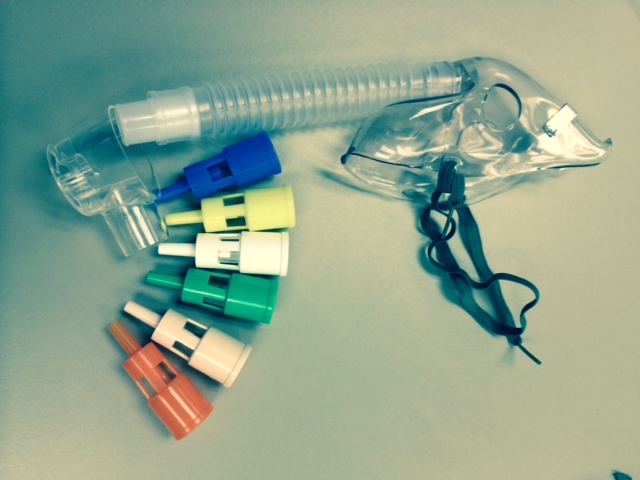 |
| Figure 1. Photos taken by Janelle Gardiner September 15, 2014 |
 |
| Figure 2 |
 |
| Figure 3 |
Each colored adapter is noted for a different fraction of inspired oxygen (FiO2), ranging from 24-50%. The colored adapter changes the rate at which the oxygen flows through the device, and influences the amount of room air (21% oxygen) to be entrained. In this case the air-entrainment ports remain the same size. The flow injection port changes size in each color. This is what changes the amount of oxygen delivered.
Figure 2 is a picture of a different type of air-entrainment mask. In this mask, the size of the air-entrainment port is adjustable to determine the amount of oxygen to be delivered (Aehlert, 2007). Figure 3 is a picture of an air-entrainment nebulizer. The amount of oxygen delivered by the nebulizer is based on the same Venturi principle, as the air-entrainment port is adjustable for varying FiO2 delivery (White, 2013).
Total Flow
When using an air-entrainment device, a respiratory therapist needs to ensure the flow to a device is adequate to meet the patient's inspiratory flow demand. The total flow to the device must meet or exceed their demand to ensure the set FiO2 is being delivered.
The total flow delivered to the patient can be determined by using this formula:
Total flow = (air to oxygen entrainment factor) (set liter flow to the device)
Instructions for determining the air to oxygen entrainment ratios will be provided in another discussion. For now, use the following table to determine the factor to use to calculate total flow. The FiO2 and liter flow to the device will be provided in the given scenario.
FiO2
|
Air:O2 Entrainment
Ratio
|
Factor (Air + O2
from ratio)
|
24
|
25:1
|
26
|
28
|
10:1
|
11
|
40
|
3:1
|
4
|
50
|
1.7:1
|
2.7
|
60
|
1:1
|
2
|
100
|
0:1
|
1
|
Case One:
The physician's order for the patient in room 316 reads "Venturi mask at 40%". You note that the Venturi mask indicates that the device must have 6 liters of oxygen flowing through it. What is the total flow delivered to the patient?
Respond to the discussion with your answer. Then provide your peers with another scenario to allow them to have practice calculating total flow.
Recommendations for teaching total flow:
When teaching students the concept of total flow, include methods to address the needs of visual, auditory, and kinesthetic learners. Auditory learners will benefit from hearing the lecture, and the description of how total flow is determined. They may also benefit from hearing the device in use and the varying flows through the device as the air-entrainment port is changed. Visual learners will benefit from seeing the types of mask, the varying sizes of injection ports and air-entrainment ports, and seeing the calculations performed. Kinesthetic learners will learn best by using the mask or air-entrainment nebulizer, adjusting the size of the port, changing the color-coded pieces, and connecting the device to oxygen while adjusting the flow.
References:
Aehlert, B. (2007). ACLS Study Guide (3rd ed.). VitalBook file: C. V. Mosby.
White, G. C. (2013). Basic clinical lab competencies for
respiratory care: An integrated approach (5th ed.). Clifton Park, NY:
Delmar.


